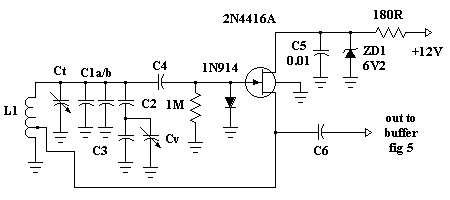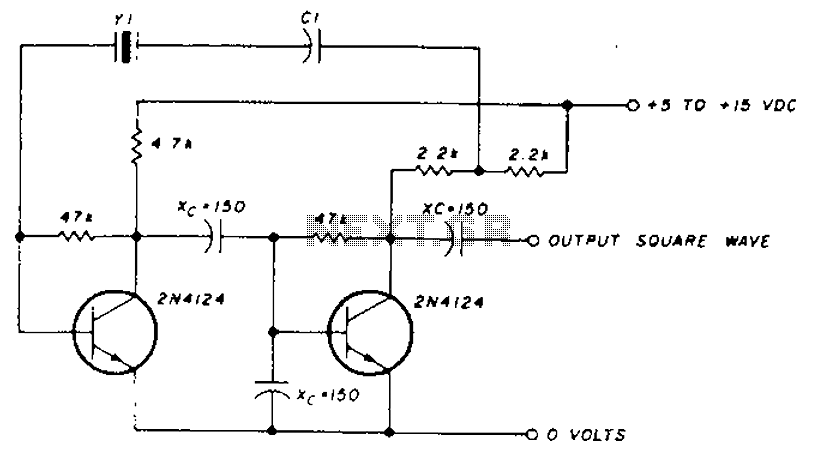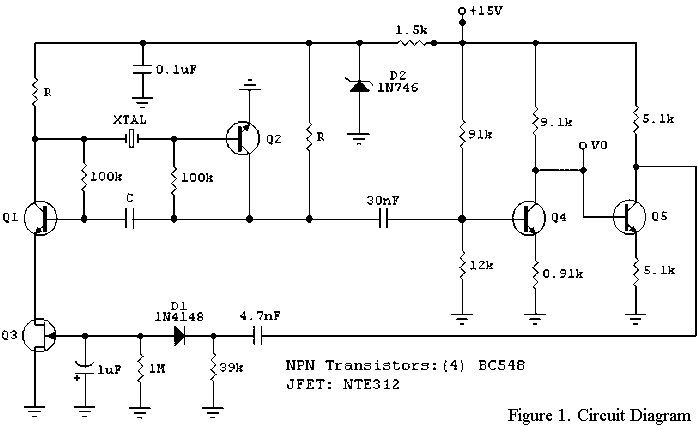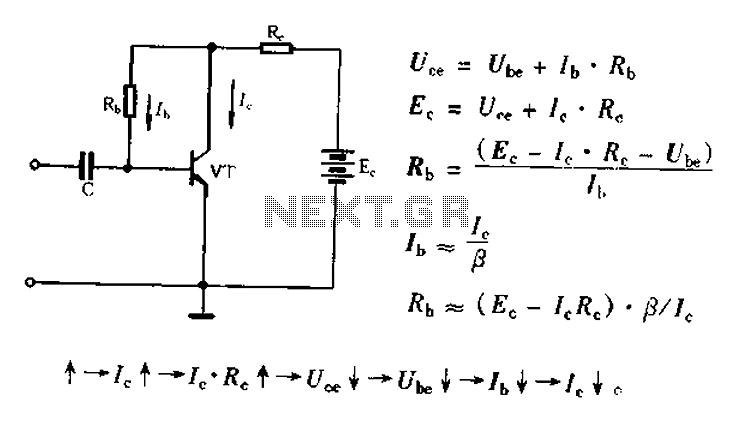
Negative Resistance Oscillator Circuits

This circuit represents a negative resistance configuration. All previous circuits utilize RC time constants to achieve resonance. LC combinations can also be employed, providing good frequency stability, high Q factor, and rapid startup. In this circuit, a signal input is controlled and amplified using the LF353 operational amplifier. The circuit employs a negative resistance configuration to generate a sine wave. The Q1-Q2 transistor pair functions as a 15 A current source, while the collector current of Q2 establishes the peak collector current for Q3. A 300 kΩ resistor and the Q4-Q5 LM394 matched transistor pair facilitate a voltage-to-current conversion that reduces the base current of Q3 when its collector voltage increases. This negative resistance characteristic enables oscillation. The operational frequency is determined by the LC components in the collector line of Q3-Q5. The LF353 FET amplifier provides gain and buffering, while the zener diode and LF353 configured as a unity gain follower eliminate power supply dependency. This circuit exhibits rapid startup and maintains distortion levels below 1.5%.
The circuit operates by leveraging the properties of negative resistance to facilitate oscillation, which is essential for generating sine waves. The arrangement of transistors Q1 and Q2 creates a robust current source, ensuring stable operation under varying load conditions. The role of the 300 kΩ resistor in conjunction with the LM394 matched transistor pair is critical for maintaining a consistent voltage-to-current conversion, which is necessary for the dynamic control of Q3's base current. As Q3's collector voltage increases, the base current is automatically adjusted, which is a fundamental aspect of the negative resistance behavior that allows for sustained oscillation.
The frequency of oscillation is primarily influenced by the LC network connected to the collector of Q3, where the inductance and capacitance values dictate the resonant frequency. This design choice is beneficial for applications requiring precise frequency stability and low distortion. The LF353 operational amplifier, known for its low noise and high bandwidth, serves to amplify the oscillating signal while also buffering it to prevent loading effects that could compromise the oscillation amplitude.
In addition, the inclusion of a zener diode in the power supply path ensures that voltage fluctuations do not affect the performance of the circuit. This is particularly important in environments where power supply variations are common. The LF353 configured as a unity gain follower further isolates the output from power supply variations, enhancing the circuit's reliability.
Overall, this negative resistance oscillator circuit is characterized by its ability to produce a clean sine wave output with minimal distortion, making it suitable for various applications in signal generation and waveform shaping. Its design emphasizes stability, rapid response, and low noise, which are crucial for high-performance electronic systems.This is a circuit of negative resistance circuits. All of the preceding circuits rely on RC time constants to achieve resonance. LC combinations can also be used and offer good frequency stability, high Q and fast starting. In the circuit, signal input is control and amp using op amp LF353. This is the figure of the circuit. In this circuit, a neg ative resistance configuration is used to generate the sine wave. The Q1-Q2 pair provides a 15 A current source. Q2s collector current sets Q3s peak collector current. The 300 k © resistor and the Q4-Q5 LM394 matched pair accomplish a voltage-to-current conversion that decreases Q3s base current when its collector voltage rises. This negative resistance characteristic permits oscillation. The frequency of operation is determined by the LC in the Q3-Q5 collector line. The LF353 FET amplifier provides gain and buffering. Power supply dependence is eliminated by the zener diode and the LF353 unity gain follower. This circuit starts quickly and distortion is inside 1. 5%. 🔗 External reference
The circuit operates by leveraging the properties of negative resistance to facilitate oscillation, which is essential for generating sine waves. The arrangement of transistors Q1 and Q2 creates a robust current source, ensuring stable operation under varying load conditions. The role of the 300 kΩ resistor in conjunction with the LM394 matched transistor pair is critical for maintaining a consistent voltage-to-current conversion, which is necessary for the dynamic control of Q3's base current. As Q3's collector voltage increases, the base current is automatically adjusted, which is a fundamental aspect of the negative resistance behavior that allows for sustained oscillation.
The frequency of oscillation is primarily influenced by the LC network connected to the collector of Q3, where the inductance and capacitance values dictate the resonant frequency. This design choice is beneficial for applications requiring precise frequency stability and low distortion. The LF353 operational amplifier, known for its low noise and high bandwidth, serves to amplify the oscillating signal while also buffering it to prevent loading effects that could compromise the oscillation amplitude.
In addition, the inclusion of a zener diode in the power supply path ensures that voltage fluctuations do not affect the performance of the circuit. This is particularly important in environments where power supply variations are common. The LF353 configured as a unity gain follower further isolates the output from power supply variations, enhancing the circuit's reliability.
Overall, this negative resistance oscillator circuit is characterized by its ability to produce a clean sine wave output with minimal distortion, making it suitable for various applications in signal generation and waveform shaping. Its design emphasizes stability, rapid response, and low noise, which are crucial for high-performance electronic systems.This is a circuit of negative resistance circuits. All of the preceding circuits rely on RC time constants to achieve resonance. LC combinations can also be used and offer good frequency stability, high Q and fast starting. In the circuit, signal input is control and amp using op amp LF353. This is the figure of the circuit. In this circuit, a neg ative resistance configuration is used to generate the sine wave. The Q1-Q2 pair provides a 15 A current source. Q2s collector current sets Q3s peak collector current. The 300 k © resistor and the Q4-Q5 LM394 matched pair accomplish a voltage-to-current conversion that decreases Q3s base current when its collector voltage rises. This negative resistance characteristic permits oscillation. The frequency of operation is determined by the LC in the Q3-Q5 collector line. The LF353 FET amplifier provides gain and buffering. Power supply dependence is eliminated by the zener diode and the LF353 unity gain follower. This circuit starts quickly and distortion is inside 1. 5%. 🔗 External reference





